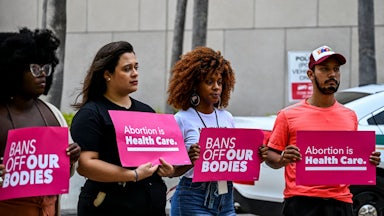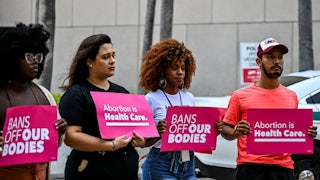One year ago, the Supreme Court overturned nearly five decades of constitutional law, declaring in Dobbs v. Jackson Women’s Health Organization that Roe v. Wade was wrongly decided and the Fourteenth Amendment right to privacy does not cover the decision—or, it turns out, even the medical necessity—to have an abortion. The ruling returned the decision to criminalize any or all abortions (or anything lawmakers might eventually decide was abortion, like so-called “abortifacients”) to the states, with no further federal oversight.
Decide they have: Twenty-three states have since passed or had go into effect laws banning many or all abortions except in cases threatening life or health, according to the Guttmacher Institute. Alabama, Arkansas, Idaho, Kentucky, Louisiana, Mississippi, Missouri, North Dakota, Oklahoma, South Dakota, Tennessee, Texas, and West Virginia now ban all abortions as a result of the decision; Georgia and North Dakota ban abortion after six gestational weeks (or two weeks after one might miss one’s first period); Nebraska and North Carolina will both soon ban it after 12 weeks; Arizona and Florida ban it after 15 gestational weeks (but if the latter’s law survives a legal challenge, it will become six weeks); and Utah after 18 (depending on the outcome of a court case that could result in a full ban). Wisconsin may still ban it depending on the outcome of a court case; Ohio is fighting in court to ban it after six weeks; Indiana is fighting a court injunction against its full ban, which became law last September.
And yet, for all the massive changes in state law and patient access, a silence has descended around how they have affected patients and doctors, in part because defying the law—or even seeming to do so—now carries so many legal and social risks.
The silence masks catastrophe. Sixty-eight percent of ob-gyns nationwide believe the decision “has worsened their ability to manage pregnancy-related emergencies,” according to a recent Kaiser Family Foundation survey. In states with abortion bans, 40 percent of ob-gyns said that “they have personally felt constraints on their ability to provide care for miscarriages and other pregnancy-related medical emergencies since the Dobbs decision.” Six in 10 doctors in those states report “their decision-making autonomy has become worse since the Dobbs ruling.”
And 64 percent of ob-gyns nationwide believe that, in less than a year, the decision has increased maternal mortality, in a country that already had the highest rate in the developed world.
The reasons for our maternal mortality rate are myriad but all come down to one, simple fact: Pregnancy is risky. In 1900, six to nine women died for every 1,000 live births, according to the Centers for Disease Control and Prevention; in 2021, the maternal mortality rate was 0.174 deaths for every 1,000 live births. And though maternal mortality dropped by record amounts between 1900 and 1982, it hasn’t declined significantly since—despite the fact that half of such deaths are still considered preventable.
(As is well documented, the mid–twentieth century push to prosecute doctors for performing abortions drove the practice underground, resulting in massive maternal mortality: By 1965, 17 percent of the maternal mortality rate was attributable to illegal abortions, often performed by unlicensed practitioners. Abortion’s legalization under Roe all but eliminated unlicensed, dangerous abortions and, with them, the associated maternal mortality. Welcome back to the future.)
In the years since Roe made abortion both legal and more accessible, most pregnant patients no longer had to go to court or fight before hospital boards for the right to have abortions to preserve their own lives. For most patients experiencing dangerous pregnancies or miscarriages, the standard of care was to terminate their pregnancies before they became truly sick or risked death—in other words, to prevent risks to their health and lives by intervening before it was an emergent medical necessity.
Catholic hospitals were (and continue to be) the exception. They have long restricted abortion care under non-emergency circumstances and have been known to both punish doctors and administrators who don’t comply with religious restrictions and allow religious administrators to make decisions for patients. Though there have been documented cases where these restrictions put pregnant patients in harm’s way or forced them to switch hospitals to obtain care, there have been no major medical studies of their impact on maternal mortality. (One study of six states, published by the National Bureau of Economic Research in 2017, hypothesized that “Catholic affiliation may increase the rates of associated complications, but have no effect on the number of miscarriages and stillbirths.”)
But the newly enacted abortion bans, like Catholic doctrine, are absolute: There are exceptions for the immediate life or health of the patient, but not their future wellbeing.*
And, like the doctors who faced prosecution two generations ago and the patients then driven underground, the resulting silence—and silencing—in the face of abortion bans has been telling, especially when you consider the exceptions to that silence.
There is Indiana’s Dr. Caitlin Bernard, who was recently sanctioned for telling a reporter about an unnamed, pregnant 10-year-old Ohio rape victim forced to travel across state lines to obtain an abortion. (Often left unsaid are the obvious physical risks for a 10-year-old to attempt to carry a pregnancy to term.)
There was would-be Texas mom Amanda Zurawski, who was forced to continue a dangerous miscarriage until she was sick enough to have the right to abortion care; I reviewed her medical records with her cooperation and it was shocking how long her doctors (notably, at a Catholic hospital) were forced to wait to treat her. She doesn’t know if she’ll ever be able to conceive again because of the damage she sustained.
There is Christina Zielke, a Washington, D.C., resident who began miscarrying at an Ohio wedding last year but was refused treatment because her health wasn’t deemed at sufficient risk to legally justify the only procedure that could prevent her suffering: an abortion.
In Oklahoma, Jaci Statton recalled that emergency room workers told her in the midst of a miscarriage to wait in the parking lot until she “crashed,” so she’d be closer to help when she was sick enough to qualify for abortion care under state law. (“We cannot touch you unless you are crashing in front of us or your blood pressure goes so high that you are fixing to have a heart attack,” she recalled them saying.)
Carmen Broesder visited the E.R. near her Idaho hometown three times and her own ob-gyn once amid a painful, bloody miscarriage that lasted 19 days before she was finally granted a medical intervention for an embryo stuck in her cervix; she recorded one doctor explicitly telling her that he didn’t want to perform the abortion she needed for her health because of their state’s anti-abortion laws.
Floridian Anya Cook’s water broke at 16 weeks last December, but E.R. doctors sent her home because they could still detect fetal cardiac activity. The amniotic sac’s rupturing not only guaranteed the pregnancy was doomed but put her at risk of fatal complications, yet they made her wait two days and only treated her once she began hemorrhaging in a salon bathroom. (She had gone to the salon because, sure the complications would kill her, she wanted her hair to look good in her casket.) She survived despite losing half of her blood and may never be able to get pregnant again as a result of the wait.
As many as one million pregnancies end in miscarriage annually, meaning that these women’s stories are likely only the public tip of a very large and very horrible iceberg. We don’t know how many women have been silenced by the grave because medical care—delayed by these unjust laws—came too late.
Abortion bans prevent doctors from providing patients with all their safe medical options; they prevent physicians, in many cases, from telling their patients that options like abortion exist, even in other states. The laws in Texas specifically force patients to be silent about their plans, lest they expose their providers, friends, or family to lawsuits for any assisting in obtaining an abortion; Marcus Silva is suing his now–ex-wife’s friends for exactly that. These laws discourage patients who are undergoing miscarriages from even expressing ambivalence about their pregnancies, lest they be prosecuted for supposedly having an abortion (which was already not uncommon pre-Dobbs). They leave patients who already feel scared and alone with few options for treatment, comfort, or resolution.
These laws encourage silence, when we already know what it causes: Silence drives abortion underground, making it less safe; silence keeps pregnant patients from accessing care that protects their health and lives before they are sick and dying; silence diminishes access to the standard of care every patient deserves.
What these laws do not do is protect life. Instead, they protect unscientific, dangerous myths about pregnancy and women’s bodies that make everyone less safe.
* This article originally mischaracterized the newly enacted abortion bans.










